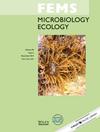Inhibition profile of three biological nitrification inhibitors and their response to soil pH modification in two contrasting soils
IF 3.5
3区 生物学
Q2 MICROBIOLOGY
引用次数: 0
Abstract
Up to 70% of the nitrogen (N) fertilizer applied to agricultural soils is lost through microbially mediated processes, such as nitrification. This can be counteracted by synthetic and biological compounds that inhibit nitrification. However, for many biological nitrification inhibitors (BNIs), the interaction with soil properties, nitrifier specificity, and effective concentrations are unclear. Here, we investigated three synthetic nitrification inhibitors (SNIs) (DCD, DMPP, and nitrapyrin) and three BNIs (methyl 3(4-hydroxyphenyl) propionate (MHPP), methyl 3(4-hydroxyphenyl) acrylate (MHPA), and limonene) in two agricultural soils differing in pH and nitrifier communities. The efficacies of SNIs and BNIs were resilient to short-term pH changes in the neutral pH soil, whereas the efficacy of some BNIs increased by neutralizing the alkaline soil. Among the BNIs, MHPA showed the highest inhibition and was, together with MHPP, identified as a putative AOB/comammox-selective inhibitor. Additionally, MHPA and limonene effectively inhibited nitrification at concentrations comparable to those used for DCD. Moreover, we identified the effective concentrations at which 50 and 80% of inhibition is observed (EC50 and EC80) for the BNIs, and similar EC80 values were observed in both soils. Overall, our results show that these BNIs could potentially serve as effective alternatives to SNIs currently used.两种不同土壤中三种生物硝化抑制剂的抑制情况及其对土壤 pH 值变化的响应
农业土壤中施用的氮(N)肥料有高达 70% 是通过硝化等微生物介导的过程流失的。这可以通过抑制硝化的合成和生物化合物来抵消。然而,许多生物硝化抑制剂(BNIs)与土壤特性、硝化剂特异性和有效浓度之间的相互作用尚不清楚。在这里,我们在两种 pH 值和硝化细菌群落不同的农用土壤中研究了三种合成硝化抑制剂(SNIs)(DCD、DMPP 和 nitrapyrin)和三种 BNIs(3(4-羟基苯基)丙酸甲酯(MHPP)、3(4-羟基苯基)丙烯酸甲酯(MHPA)和柠檬烯)。在 pH 值为中性的土壤中,SNIs 和 BNIs 的功效不受短期 pH 值变化的影响。在 BNIs 中,MHPA 的抑制率最高,它与 MHPP 一起被确定为一种假定的 AOB/comammox 选择性抑制剂。此外,MHPA 和柠檬烯可有效抑制硝化作用,其浓度与用于 DCD 的浓度相当。此外,我们还确定了 BNIs 抑制 50% 和 80% 的有效浓度(EC50 和 EC80),并在两种土壤中观察到了相似的 EC80 值。总之,我们的研究结果表明,这些 BNIs 有可能成为目前使用的 SNIs 的有效替代品。
本文章由计算机程序翻译,如有差异,请以英文原文为准。
求助全文
约1分钟内获得全文
求助全文
来源期刊

FEMS microbiology ecology
生物-微生物学
CiteScore
7.50
自引率
2.40%
发文量
132
审稿时长
3 months
期刊介绍:
FEMS Microbiology Ecology aims to ensure efficient publication of high-quality papers that are original and provide a significant contribution to the understanding of microbial ecology. The journal contains Research Articles and MiniReviews on fundamental aspects of the ecology of microorganisms in natural soil, aquatic and atmospheric habitats, including extreme environments, and in artificial or managed environments. Research papers on pure cultures and in the areas of plant pathology and medical, food or veterinary microbiology will be published where they provide valuable generic information on microbial ecology. Papers can deal with culturable and non-culturable forms of any type of microorganism: bacteria, archaea, filamentous fungi, yeasts, protozoa, cyanobacteria, algae or viruses. In addition, the journal will publish Perspectives, Current Opinion and Controversy Articles, Commentaries and Letters to the Editor on topical issues in microbial ecology.
- Application of ecological theory to microbial ecology
- Interactions and signalling between microorganisms and with plants and animals
- Interactions between microorganisms and their physicochemical enviornment
- Microbial aspects of biogeochemical cycles and processes
- Microbial community ecology
- Phylogenetic and functional diversity of microbial communities
- Evolutionary biology of microorganisms
 求助内容:
求助内容: 应助结果提醒方式:
应助结果提醒方式:


